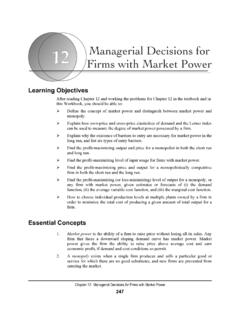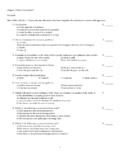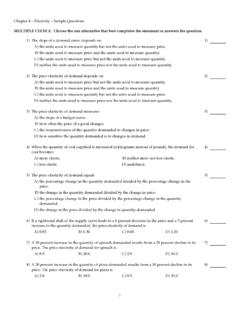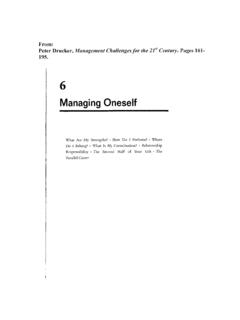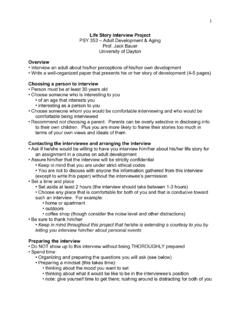Transcription of Chapter 10 - Output and Costs - Sample Questions …
1 Chapter 10 - Output and Costs - Sample Questions MULTIPLE CHOICE. Choose the one alternative that best completes the statement or answers the question . 1) The short run is a period of time in which 1). A) nothing the firm does can be altered. B) the amount of Output is fixed. C) prices and wages are fixed. D) the quantities of some resources the firm uses are fixed. 2) The short run is a period of time in which 2). A) Output prices are fixed. B) the quantity used of at least one resource is fixed. C) resource prices are fixed. D) the quantities used of all resource are fixed. 3) The short run is a time frame in which 3). A) the quantities of some resources are fixed and the quantities of other resources can be varied.
2 B) the quantities of all resources are fixed. C) the quantities of all resources can be varied. D) all Costs are sunk Costs . 4) An example of a variable resource in the short run is 4). A) an employee. B) capital equipment. C) land. D) a building. 5) A cost that has already been made and cannot be recovered is called a 5). A) marginal cost . B) fixed cost . C) variable cost . D) sunk cost . 6) The long run is a time frame in which 6). A) the quantities of all resources are fixed. B) the quantities of all resources can be varied. C) the quantities of some resources are fixed and the quantities of other resources can be varied. D) all Costs are sunk Costs . 7) In the long run, a firm can vary 7). A) its capital but not its labor.
3 B) its labor but not its capital. C) both its labor and its capital. D) neither its labor nor its capital. 8) The long run is distinguished from the short run in that, in the long run, 8). A) Output prices can vary. B) the firm no longer maximizes its profit. C) resource prices can vary. D) the quantities of all resources can be varied. 1. 9) The marginal product of labor is the increase in total product from a 9). A) one dollar increase in the wage rate, while holding the price of capital constant. B) one unit increase in the quantity of labor, while also increasing the quantity of capital by one unit. C) one unit increase in the quantity of labor, while holding the quantity of capital constant. D) one percent increase in the wage rate, while also increasing the price of capital by one percent.
4 10) The marginal product of labor is the change in total product from a one-unit increase in 10). A) the wage rate. B) both the quantity of labor and the quantity of capital employed. C) the quantity of labor employed, holding the quantity of capital constant. D) the quantity of capital employed, holding the quantity of labor constant. 11) The marginal product of labor is the 11). A) Output level above which the slope of the total product curve falls. B) Output level above which the rate of total product per unit of labor falls. C) maximum Output attainable with fixed factors when labor is the only variable factor. D) change in Output resulting from a one-unit increase in labor. 12) The average product of labor is 12).
5 A) the inverse of the average product of capital. B) total product divided by the total quantity of labor employed. C) the slope of the curve showing the total product of labor. D) the slope of the curve showing the marginal product of labor. 13) Average product is the 13). A) maximum Output attainable with fixed factors and one variable factor. B) total product per unit of an input. C) change in total product due to a one unit change in input. D) total product divided by the total cost . Total Product, Marginal Product, Average Product Labor Total product Marginal Average (workers per day) (units per day) product product 0 0 0 0. 1 2 2 2. 2 8. 3 12. 4 15. 5 16 1. 14) In the above table, the total product that is produced when the firm employs four workers is 14).
6 A) 8 . B) 15. C) D) 3. 15) In the above table, the marginal product of the third worker is 15). A) 2. B) 1. C) 4. D) 3. 2. 16) In the above table, the marginal product of the fourth worker is 16). A) 6. B) 3. C) 1. D) 4. 17) In the above table, the marginal product is greatest when the 17). A) third worker is hired. B) second worker is hired. C) fourth worker is hired. D) first worker is hired. 18) In the above table, the average product of three workers is 18). A) 1. B) 4. C) 3. D) 2. 19) In the above table, the average product is less than the marginal product 19). A) when the first worker is hired. B) when the second worker is hired. C) for the entire range of Output given. D) when the third worker is hired.
7 20) Points below a firm's total product curve are 20). A) technologically efficient but not attainable. B) both attainable and technologically efficient. C) attainable but not technologically efficient. D) neither attainable nor technologically efficient. 21) Points on a firm's total product curve are 21). A) both attainable and technologically efficient. B) neither attainable nor technologically efficient. C) technologically efficient but not attainable. D) attainable but not technologically efficient. 22) When the total product curve is drawn in a figure that measures employment along the horizontal 22). axis, it is a graph that shows the A) maximum Output attainable for each quantity of labor employed.
8 B) minimum cost of producing a given amount of Output using different techniques. C) maximum profit attainable for each unit of Output sold per unit of labor employed. D) minimum Output attainable for each quantity of labor employed. 3. 23) In the figure above, the marginal product of the second worker is 23). A) 10 units. B) 2 units. C) 5 units. D) 1 units. 24) In the above figure, after the second worker is hired, the marginal product of labor is 24). A) constant. B) increasing. C) zero. D) diminishing. 25) At point d in the above figure, the average product of labor equals 25). A) approximately 1. B) C) 15. D) 4. 26) In the above figure, the average product of labor at point c is 26). A) 5. B) 2.
9 C) 10. D) None of the above answers are correct. 27) In the figure above, 27). A) f is an efficient point. B) g is an efficient point. C) d is an efficient point. D) there are no efficient points. 28) In the above figure, an inefficient point is 28). A) a. B) f. C) g. D) e. 29) In the above figure, an unattainable point is 29). A) a. B) e. C) f. D) g. 30) In the above figure, the most efficient way to produce 10 units is to hire 30). A) 1 worker. B) 5 workers. C) 2 workers. D) 3 workers. 31) In the above figure, the most efficient way to produce 15 units is to hire 31). A) 5 workers. B) 3 workers. C) 4 workers. D) 2 worker. 4. 32) In the above figure, the maximum number of units that 4 workers can produce is 32).
10 A) 15 units. B) more than 15 units. C) 5 units. D) 10 units. 33) In the above figure, the marginal product of labor is zero at point 33). A) a. B) f. C) e. D) c. 34) At point e in the above figure, the marginal product of labor definitely 34). A) is at its maximum. B) is less than the average product of labor. C) equals the average product of labor. D) is greater than the average product of labor. 35) The steeper the slope of the total product curve, the 35). A) more efficient is the technology employed. B) higher is the level of the total cost curve. C) larger is the marginal product of labor. D) smaller is the marginal product of labor. 36) Increasing marginal returns to labor might occur at low levels of labor input because of 36).
